Lesser grison facts for kids
Quick facts for kids Lesser grison |
|
|---|---|
 |
|
| Conservation status | |
| Scientific classification | |
| Genus: |
Galictis
|
| Species: |
cuja
|
 |
|
| Lesser grison range | |
The lesser grison (Galictis cuja) is a small, weasel-like animal. It lives in South America. This creature belongs to the mustelid family. This family also includes badgers, otters, and ferrets. Lesser grisons are known for their sleek bodies and active lives.
Contents
What They Look Like
Lesser grisons have a long, slender body and short legs. They also have a bushy tail. Their neck is long, and their head is small. They have a flattened forehead and rounded ears. These animals are smaller than their close relative, the greater grison.
Their body, from head to rump, is about 27 to 52 centimeters (11 to 20 inches) long. Their tail adds another 14 to 19 centimeters (5.5 to 7.5 inches). Adult lesser grisons usually weigh between 1.2 and 2.4 kilograms (2.6 to 5.3 pounds). Female grisons are a bit smaller and thinner than males.
The top of their head, back, sides, and tail are a grizzled grey color. This color comes from coarse black hairs with buff-colored tips. Underneath, they have a softer undercoat. The rest of their body is black or very dark. They have a pale buff stripe that runs from their forehead to their shoulders. This stripe is along the lower edge of their grey fur. Their feet have five toes and are slightly webbed. Each toe ends in a sharp, curved claw.
Where They Live and Their Home
Lesser grisons are found across most of southern South America. They live from sea level up to high mountains, sometimes as high as 4,200 meters (13,800 feet). They can live in many different places. These include grasslands, forests, scrublands, and mountain meadows. They usually live near water. Sometimes, they also live on farms and pastures.
There are four recognized types, or subspecies, of lesser grisons:
- Galictis cuja cuja – found in southwestern Bolivia, western Argentina, and central Chile
- Galictis cuja furax – found in southern Brazil, northeastern Argentina, Uruguay, and Paraguay
- Galictis cuja huronax – found in south-central Bolivia and eastern Argentina
- Galictis cuja luteola – found in the very south of Peru, western Bolivia, and northern Chile
Biology and Behaviour
Lesser grisons are carnivorous animals. This means they eat meat. They hunt small to medium-sized rodents. They also eat rabbits, birds, frogs, lizards, and snakes. They are a main predator of cavies, which include wild guinea pigs. They also hunt nesting grebes (a type of water bird).
They walk partly on the soles of their feet. This is called being semi-plantigrade. Even though their feet are slightly webbed, they are better for running and climbing than for swimming. Lesser grisons have special scent glands near their rear. These glands can spray a strong-smelling liquid. It's similar to a skunk's spray, but probably not as strong.
Lesser grisons are monogamous, meaning a male and female usually stay together. They hunt together when they are raising their young. A mother grison usually has two to five babies in a litter.
These animals mostly hunt during the day. They use their strong sense of smell to find prey. They can live alone or in small family groups. These groups include parents and their young. When they travel together, they often walk in a single file line. Lesser grisons are known to be quite fierce. They sometimes play with their food for a long time before eating it. At night, they sleep in hollow trees or natural cracks in rocks. They also dig burrows. These burrows can be as deep as 4 meters (13 feet). They often hide the entrances with leaves.
Relations with Humans
Lesser grisons can be tamed if they are raised from a young age. In the past, people used them to hunt wild chinchillas. The grisons would chase the chinchillas down their burrows, much like ferrets do. However, chinchillas are now very rare, so this practice is no longer common.
Sometimes, people still keep lesser grisons to help control rodents on farms. But grisons can also be hunted, especially if they are thought to prey on chickens or other farm birds. Sadly, they are also often hit by cars on roads in Brazil.
Lesser grisons can carry a disease called Chagas disease. Their bodies have also been used as magical charms in Bolivia.
See also
 In Spanish: Grisón menor para niños
In Spanish: Grisón menor para niños


